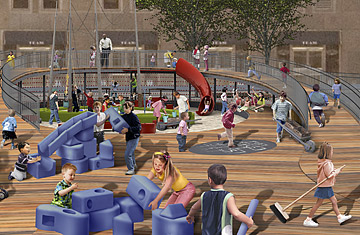
An artist's rendering of the Imagination Playground to be built in lower Manhattan
It's happened to every parent: you buy little Sammy the hottest new toy, and he's more excited to play with the box it came in and the Styrofoam peanuts.
New York City–based architect David Rockwell has come up with some ingenious ways to amplify that familiar scene and, in the process, is bringing to the U.S. the most innovative playground design since child psychologists started fiddling with jungle gyms in the 1960s. Dubbed the Imagination Playground in a Box, his creation takes sand and water — two things all kids love — and adds in dozens of loose parts: foam building blocks of various shapes and sizes, buckets, wheelbarrows, brooms and shovels. All these elements come neatly stored in a mobile shipping container. "You just open this thing up, and kids' fantasy worlds instantly kick in," Rockwell says. "They use the parts to build cities, houses, castles, spaceships, even sewer systems." (Read about David Rockwell and more of today's 100 most influential designers.)
Rockwell is renowned for his adult playgrounds — chic hotels, restaurants and casinos he has designed around the world. But shortly after Sept. 11, 2001, the father of two had a vision for a new playground for lower Manhattan. Construction on that site, the first permanent Imagination Playground, is set to begin this week. Instead of swings or other standard play equipment, there will be movable objects that children can use to build and tear down, thus ensuring a different experience with each trip to the figure-eight-shaped playground. (See pictures of architects building for the 21st century.)
But Rockwell didn't want to limit the fun to just one place. So he came up with a portable version that is meant to complement existing play structures, not replace them. Through a partnership with kid-focused nonprofit Kaboom!, Imagination Playground in a Box is expected to arrive at more than 1,000 parks and schools nationwide within the next five years. "Demand is also tremendous from day-care centers, pediatricians' offices and children's museums," says Kaboom! founder Darrell Hammond. "This could fundamentally change adults' ideas of how children play."
Or rather, turn back the clock to a more innocent age. Over the past several decades, playgrounds "have increasingly become less fun as we worry more and more about liability," says Adrian Benepe, New York City's Parks and Recreation commissioner. "So much so that we've effectively dumbed them down in the name of safety." In doing so, Hammond adds, "we've created a generation that would rather play video games or watch TV than run around outside." (See 10 things to do in New York City.)
The push to rethink playgrounds comes amid the childhood-obesity epidemic — one-third of American children are now overweight, compared with 4% in 1970 — as well as the movement to make playgrounds more accessible to disabled and autistic kids. About 150 playgrounds in 29 states and Canada have been constructed to the standards of Connecticut-based nonprofit Boundless Playgrounds, which secures grants for some simple improvements — like raising up sandboxes to accommodate children in wheelchairs and installing recliner-shaped swings for kids who need help sitting up — to more complicated ones, such as adding padded nooks for kids who need enclosed spaces or substituting a rubber ground for the wood chips currently used in many play areas. "Recreation is not just about fun and games. It's about building social skills and developing a child's mind," says Boundless Playground CEO Fred Leone. "Every child, with disabilities or not, has a right to that." (Read about the link between green space and kids' gaining less weight.)
But accessibility does carry a higher price tag. Leone acknowledges that Boundless Playgrounds do cost a community more. The organization raised more than $2.5 million last year to help defray the additional expenses in several municipalities. Rockwell and Kaboom! are exploring how royalties from the Imagination Playground in a Box — the portable wonderlands cost approximately $6,500 a pop — can fund an endowment to cover one rather significant, ongoing cost: a paid Play Associate, i.e., a trained adult who can help direct play while ensuring that those loose parts don't go missing. "It's a model we've borrowed from England," Rockwell says. "That person is in charge of fostering collaboration and creativity."
At its core, Rockwell's Imagination Playground simply gives children more stuff to do with sand and water. "Kids need to dig in the dirt, take risks, fall down and get back up," Benepe says. "That's the only way to teach them how to work together and build the great cities of the future." Or, at the very least, the next cool playground.
